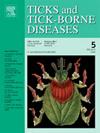Ferritin-mediated regulation of gut microbiota homeostasis promotes blood-feeding adaptation in the tick Haemaphysalis doenitzi
IF 3.4
2区 医学
Q2 INFECTIOUS DISEASES
引用次数: 0
Abstract
As obligate hematophagous parasites, ticks have evolved to cope with substantial amounts of iron and exogenous microorganisms present in host blood during feeding. In ticks, ferritin plays an important role in maintaining the oxidative balance of gut and the homeostasis of the microbial community structure, but its regulatory mechanism has not yet been clarified. This study successfully identified a ferritin gene from Haemaphysalis doenitzi, named Hd-fer, and further studied the function of Hd-fer. The results showed that rHd-fer had antioxidant properties and antibacterial activity. The expression of Hd-fer gene in the ovary and midgut was significantly higher than other organs, and the expression in adults was significantly higher than other stages. The Hd-fer gene knock-out significantly changed the abundance of the midgut microbial community, and the relative abundance decreased generally, while the relative abundance of Achromobacter increased. The knockout of Hd-fer gene also significantly changed the structural composition of the midgut microbial species, and pathogenic microorganisms showed a growing trend, producing their unique microbial genera, including Barnesiellaceae, Carnobacterium and Pediococcus. The RNA interference of Hd-fer led to prolonging the tick's blood sucking time and reducing engorged weight. The results of this study showed that Hd-fer may affect the stability of the midgut microbial community structure by regulating iron availability, which in turn plays an important role in the survival and reproduction of ticks. These findings provide novel insights into the role of ferritin in tick biology and highlight its potential as a target for controlling tick-borne diseases.
铁蛋白介导的肠道微生物群稳态调节促进蜱血蜱的吸血适应。
作为专性食血寄生虫,蜱虫已经进化到能够应对宿主血液中大量的铁和外源微生物。在蜱中,铁蛋白在维持肠道氧化平衡和微生物群落结构的稳态中起着重要作用,但其调控机制尚不清楚。本研究成功地从多尼茨血蜱中鉴定出一个铁蛋白基因,命名为Hd-fer,并进一步研究了Hd-fer的功能。结果表明,黄芪多糖具有抗氧化和抑菌活性。Hd-fer基因在卵巢和中肠的表达量显著高于其他脏器,在成虫中的表达量显著高于其他脏器。Hd-fer基因敲除显著改变了中肠微生物群落的丰度,其相对丰度普遍降低,而无色杆菌的相对丰度升高。Hd-fer基因的敲除也显著改变了中肠微生物种类的结构组成,致病微生物呈增长趋势,产生了其独特的微生物属,包括Barnesiellaceae、Carnobacterium和Pediococcus。Hd-fer的RNA干扰导致蜱虫吸血时间延长,充血体重减轻。本研究结果表明,Hd-fer可能通过调节铁的有效性来影响中肠微生物群落结构的稳定性,从而在蜱的生存和繁殖中发挥重要作用。这些发现为铁蛋白在蜱生物学中的作用提供了新的见解,并突出了它作为控制蜱传疾病的靶点的潜力。
本文章由计算机程序翻译,如有差异,请以英文原文为准。
求助全文
约1分钟内获得全文
求助全文
来源期刊

Ticks and Tick-borne Diseases
INFECTIOUS DISEASES-MICROBIOLOGY
CiteScore
6.90
自引率
12.50%
发文量
185
审稿时长
6-12 weeks
期刊介绍:
Ticks and Tick-borne Diseases is an international, peer-reviewed scientific journal. It publishes original research papers, short communications, state-of-the-art mini-reviews, letters to the editor, clinical-case studies, announcements of pertinent international meetings, and editorials.
The journal covers a broad spectrum and brings together various disciplines, for example, zoology, microbiology, molecular biology, genetics, mathematical modelling, veterinary and human medicine. Multidisciplinary approaches and the use of conventional and novel methods/methodologies (in the field and in the laboratory) are crucial for deeper understanding of the natural processes and human behaviour/activities that result in human or animal diseases and in economic effects of ticks and tick-borne pathogens. Such understanding is essential for management of tick populations and tick-borne diseases in an effective and environmentally acceptable manner.
 求助内容:
求助内容: 应助结果提醒方式:
应助结果提醒方式:


